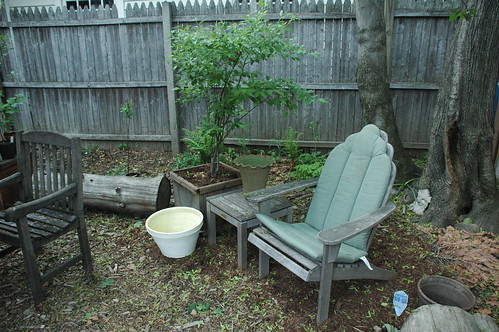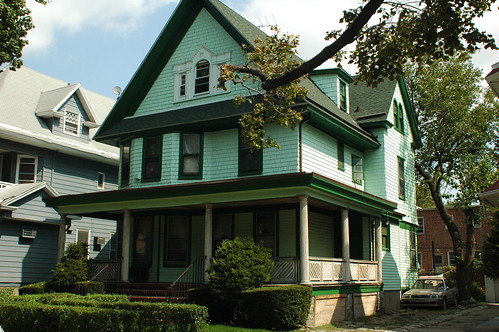Label, “Our Lady of Abundance,” inside the lid of a reliquary box by Grace Gunning.

- Coda
- 1) An endnote, or final word, in which the author elucidates what has come before.
2) A few measures or a section added to the end of a piece of music to make a more effective ending.
This afternoon we picked up Spot’s ashes and brought them home.
She died three weeks ago. By the time we got her to the veterinary emergency room, she was already gone. In that emotional haze, we had to make a decision about what to do. We chose individual cremation. Three days ago, we got the call that her ashes were ready to be picked up.
John and I had discussed what container we might use for her ashes. We thought of a small, bronze triangular nested box inscribed with Celtic designs which we bought a couple of years ago. But we didn’t know how much … material the box would need to hold. I didn’t think it could be very much. Then I remembered we had the reliquary box. I bought it for John. He’d kept it first in his apartment, then we had it in our first apartment. We hadn’t found a place for it since we moved into our house three years ago, but I remembered seeing it recently inside one of the opened, still unpacked, moving boxes.

Over the past three weeks, John and I have gone through the familiar phases and states of grieving. I told John last night that, over the past three days, the main feeling for me has been, “I want to bring her home.” I know that “she” is gone. There are layers to the emotional acceptance of that loss.
When I re-read my first diary entries about her, what’s remarkable is that her personality was so present in them. She was always affectionate. When I came home, she demanded my attention. But however hungry she was, she insisted that I first pick her up and “schmoosh” her. She would purr, deeply and resonantly. Then I could set her down and she could eat. That I was able to give a flea bath to a strange cat without her fighting me was all about her gentle, compliant, trusting nature. Even the vet would always remark how calm and cooperative she was.
The most difficult moments have not been the physical reminders of her: her toys, her brushes, her scratching post, her bowls, her litter box. Gradually, we’ve packed these up and put them away. The absences have been the hardest. When I leave the house, she doesn’t follow me downstairs, trying to sneak outside. When I come home, she doesn’t greet me at the top of the stairs. When I go to bed, she’s not there to “tuck me in.” She’s not there to paw my face in the morning and wake me up.
I peeled back some of the final layers of acceptance today. I called ahead before we drove over: “We’ve never done this before. I don’t know what to expect. Is there a bag? A box?” The woman I spoke with said there’s a bag inside a metal box. It was more thoughtfully elaborate than that.
There was a paper bag tied with a ribbon. Inside the bag was a condolence card and some promotional literature (not so thoughtful) from the pet cemetery where the cremation was done. Also inside, green tissue paper wrapped a small metal tin, something like what you might keep loose tea in. We had brought the reliquary box with us, but the tin’s size and shape wouldn’t fit inside. That’s as far as we explored it at the E.R.
Gardener’s corner in the backyard

When we got home, I went and sat in the backyard. It was a sunny day, and it was still early enough in the afternoon that the house wasn’t yet shading the gardener’s corner. After parking the car, John came and sat beside me. Here I carefully opened the metal canister. Inside this, more green tissue paper wrapped the bag containing her ashes. John opened the lid of the box, and we placed the small, green package in its center. I remarked, “She always liked the sun.” We cried and held hands for a few minutes.
The reliquary lid didn’t quite fit over the little green package. When we got back inside, I took it out of the reliquary and started unwrapping the tissue paper. I wanted to reshape the bag to better fit inside the reliquary. I was also curious, and knew I needed, to see the ashes themselves. When I got to the last wrap, I got a glimpse, covered it back up, and held the package in both hands, tears running from my eyes. John asked, “What is it?” I said, “I don’t know what I was expecting.” Consciously, I was expecting my mental image of “ash”: gray and dusty, powdery. Instead, it was white, chalky, gritty with tiny fragments of bone. I wasn’t ready for that. Another time, I’ll be ready to unwrap that final layer. I wrapped it with some ivory cloth as a shroud and returned it to the box.
I appreciate all the comments, cards, and phone messages we’ve received. What I write now is not to diminish anyone else’s beliefs, nor the sentiments they’ve expressed. I don’t believe in anything. If there were a heaven, animals would be there. If there were angels, they would be animals. But I don’t believe in heaven, or angels, or gods, or any life other than the one I’m living.
Death is final. I knew that as Spot was dying in my arms. I knew that her limp tail – which had been so expressive of her presence and personality – meant she was already gone from us. I don’t know how much she was aware of at the very end, when we were driving her to the E.R., and I cradled her in my arms, and she cried out for the last time, and I lifted her up and turned her face to mine because she couldn’t do it herself. I hope my face was the last thing she saw, but I’ll never know. I know she was gone from us as the last breath left her body and her heart stopped beating beneath my fingers.
Despite my skepticism and disbelief, I have come to accept that spirituality and ritual are important to me. The box itself holds layers of memory and meaning which make it an appropriate resting place for Spot’s remains. I bought it six-and-a-half years ago, when John and I had not yet moved into our first apartment together. I was still living in my garden apartment on 5th Street in Park Slope, where Spot had found me. John and I were well underway in our adventure of exploring relationship with each other. Spot was there to nurture us on that journey.
John and Spot on the couch in the 5th Street apartment

On September 10, 2001, John and I went on vacation upstate. The next morning, from a distance, we watched our world change. For that week, we were ambassadors, representatives of New York City and all that had happened there. When we met people upstate and they learned where we were from, their faces and postures changed. Some were brought to tears. Like it or not, we carried a responsibility everywhere we went.
I think it was in Kingston where I found the box in a gift store. They had a couple of these reliquary boxes, and I wanted to buy John one. I bought some chimes there with him, then he went outside. When I saw that this one was titled “Our Lady of Abundance,” I knew this was the one. “Abundance” was a word we used deliberately and frequently at that time to try to describe the richness we felt in our lives, as well as the challenges we faced in accepting it.
The title of the box is stamped into the inside of the lid. It’s signed with a power tool on the underside.

Today this box became a true reliquary, holding the relic of Spot, that time when we were learning to accept abundance into our life together, and the memories of that terrible week.
Related Posts
Spot, February 23
My Flickr photo sets of the box and Spot
Links
Grace Gunning, Copper Reliquary Boxes


























































